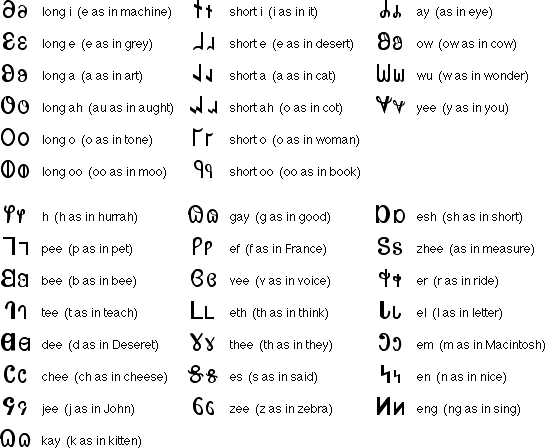Deseret alphabet 
Origin
The Deseret Alphabet was devised as an alternative to
the Latin alphabet for
writing the English language. It was developed during the 1850s at the
University of Deseret, now the University of Utah, and was promoted by The
Church of Jesus Christ of Latter-day Saints, also known as the "Mormon" or
LDS Church, under Church President Brigham Young (1801-1877).
The name Deseret is taken from a word in the Book of Mormon and means
"honeybee". It reflects the LDS use of the beehive as a symbol of
co-operative industry.
Brigham Young's secretary, George D. Watt, was among the designers of
the Deseret Alphabet and is thought to have used the Pitman English
Phonotypic Alphabet of 1847 as the model.
The LDS Church commissioned two typefaces and published four books
using the Deseret Alphabet. The Church-owned Deseret News also published
passages of scripture using the alphabet on occasion. In addition, some
historical records, diaries, and other materials were hand-written using
this script, and it had limited use on coins and signs. There is also one
tombstone in Cedar City, Utah, written in the Deseret Alphabet. However,
the alphabet failed to gain wide acceptance and was not actively promoted
after 1869.
Today, the Deseret Alphabet remains of interest primarily to historians
and hobbyists.

Sample text

Links
Free Deseret language kit for Mac
ftp://ftp.blueneptune.com/pub/users/tseng/Deseret/DLK.sea.hqx
Further details of the Deseret Alphabet
http://people.delphi.com/deseret/home/homealph.htm
http://www.utlm.org/onlineresources/deseretalphabet.htm
Other alternative writing systems:
Braille, Deseret,
G�y?nz�, Mesa, Moon, Morse code, Nikhilipi, Quikscript/Read
Alphabet, Shavian, Theban, Unifon, 12480
|